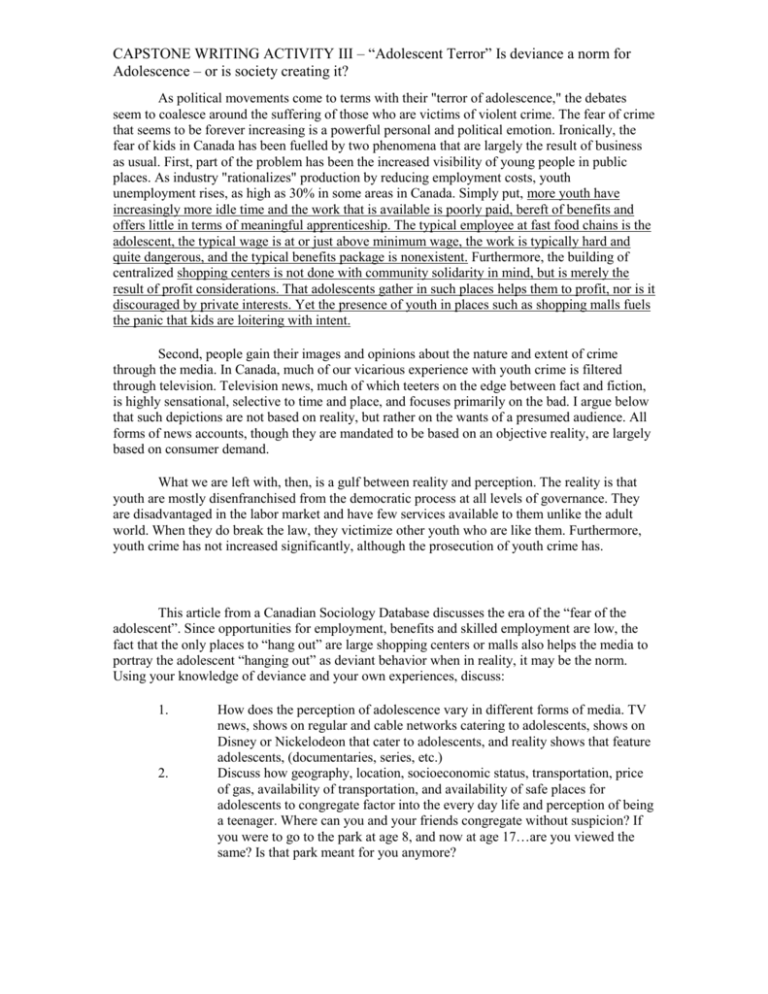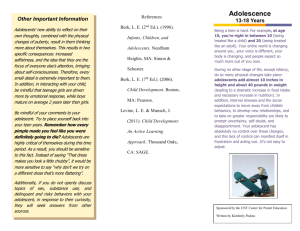"terror of adolescence," the debates seem to coalesce around the
advertisement

CAPSTONE WRITING ACTIVITY III – “Adolescent Terror” Is deviance a norm for Adolescence – or is society creating it? As political movements come to terms with their "terror of adolescence," the debates seem to coalesce around the suffering of those who are victims of violent crime. The fear of crime that seems to be forever increasing is a powerful personal and political emotion. Ironically, the fear of kids in Canada has been fuelled by two phenomena that are largely the result of business as usual. First, part of the problem has been the increased visibility of young people in public places. As industry "rationalizes" production by reducing employment costs, youth unemployment rises, as high as 30% in some areas in Canada. Simply put, more youth have increasingly more idle time and the work that is available is poorly paid, bereft of benefits and offers little in terms of meaningful apprenticeship. The typical employee at fast food chains is the adolescent, the typical wage is at or just above minimum wage, the work is typically hard and quite dangerous, and the typical benefits package is nonexistent. Furthermore, the building of centralized shopping centers is not done with community solidarity in mind, but is merely the result of profit considerations. That adolescents gather in such places helps them to profit, nor is it discouraged by private interests. Yet the presence of youth in places such as shopping malls fuels the panic that kids are loitering with intent. Second, people gain their images and opinions about the nature and extent of crime through the media. In Canada, much of our vicarious experience with youth crime is filtered through television. Television news, much of which teeters on the edge between fact and fiction, is highly sensational, selective to time and place, and focuses primarily on the bad. I argue below that such depictions are not based on reality, but rather on the wants of a presumed audience. All forms of news accounts, though they are mandated to be based on an objective reality, are largely based on consumer demand. What we are left with, then, is a gulf between reality and perception. The reality is that youth are mostly disenfranchised from the democratic process at all levels of governance. They are disadvantaged in the labor market and have few services available to them unlike the adult world. When they do break the law, they victimize other youth who are like them. Furthermore, youth crime has not increased significantly, although the prosecution of youth crime has. This article from a Canadian Sociology Database discusses the era of the “fear of the adolescent”. Since opportunities for employment, benefits and skilled employment are low, the fact that the only places to “hang out” are large shopping centers or malls also helps the media to portray the adolescent “hanging out” as deviant behavior when in reality, it may be the norm. Using your knowledge of deviance and your own experiences, discuss: 1. 2. How does the perception of adolescence vary in different forms of media. TV news, shows on regular and cable networks catering to adolescents, shows on Disney or Nickelodeon that cater to adolescents, and reality shows that feature adolescents, (documentaries, series, etc.) Discuss how geography, location, socioeconomic status, transportation, price of gas, availability of transportation, and availability of safe places for adolescents to congregate factor into the every day life and perception of being a teenager. Where can you and your friends congregate without suspicion? If you were to go to the park at age 8, and now at age 17…are you viewed the same? Is that park meant for you anymore?











